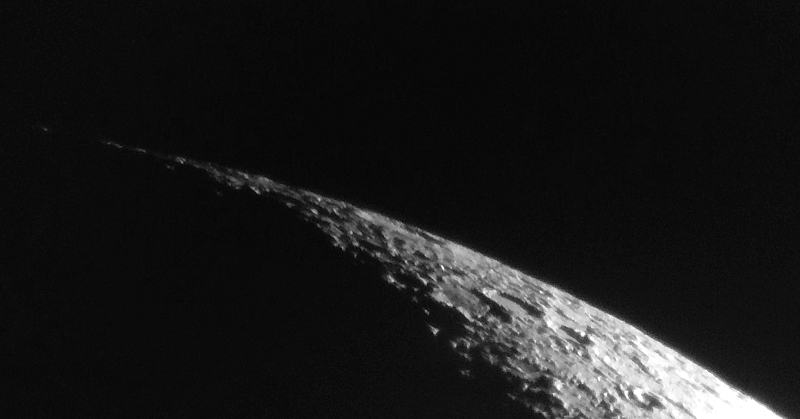Moon, NightCap Pro Constellations & M51 Galaxy,
Ganymede Eclipses Europa
Posted: 24 March 2015
After having a clear sky early Sunday morning, 22 March 2015, to photograph Nova Sagittarii 2015 No. 2, clouds began appearing mid-day. Did not open the observatory that night. The sky began clearing Monday afternoon.
|
Open: Monday, 23 March 2015, 1819 MST Temperature: 80°F |
Session: 796 Conditions: Clear |
I first synced the observatory clock to WWV for the night's Jupiter Moons Mutual Event.
1827 MST: viewed Venus, 83X. Gibbous phase visible. Then went to the Moon and took this iPhone 5s photo, afocal 77X, MX-1 Afocal Adapter:

1840 MST: sunset. Did some lunar observing, 222X. A crater on the northern limb looked interesting, so took this iPhone afocal 231X image (cropped from full-frame):

At the southern lunar pole a mountain was catching the rising sun, as seen in this iPhone afocal 231X image (cropped from full-frame):

I switched to photographing the moon with the D7000 DSLR at prime focus + 3X TeleXtender. This cropped image, "hat trick", ISO 1000, shows the southern mountains and Earthshine:

1912 MST: resumed observing the southern mountains, 222X.
1920 MST: took this iPhone 5s photo of the western sky using NightCap Pro, the Moon at the top and Venus near the center:

1939 MST: Earthshine, iPhone 5s, afocal 77X:

1947 MST: using NightCap Pro with the iPhone 5s, took this handheld photograph of the southern sky showing Orion (top right), Canis Major and the brightest star Sirius (middle left), and the second brightest star Canopus (lower left through the trees):

1955 MST: I continued observing the lunar southern mountains, 222X. 2004 MST: last look at the Moon, 83X.
2010 MST: began setting up to image M40 (double star) for my Messier Photo Album using the D7000 DSLR at prime focus of the 8" LX200-ACF. Did a focus test on the star Regulus using the Bahtinov Mask. M40, 30 seconds, ISO 1600:

2027 MST: slewed to Jupiter, removed the camera, and viewed Jupiter at 83X. The Great Red Spot and four Galilean Moons were visible. Remounted the D7000 at prime focus + 3X TeleXtender, did a focus test with the Mask on Regulus, then slewed back to Jupiter. This is a composite of two exposures (1 second and 1/30sec) at ISO 1600 (south at top):

I then did a 45 second HD video recording, 1/30sec, ISO 1600. This is a stack of 934 frames using Keith's Image Stacker (north at top), showing the Great Red Spot:

2049 MST: removed the camera from the telescope and viewed Jupiter at 222X. The Great Red Spot was nearing the central meridian.
I then slewed the 8" telescope to M51 (Whirlpool Galaxy). I did some test exposures of M51 using the iPhone 5s and NightCap Pro afocal 77X while waiting for the moon to set. I could faintly see M51 on the live screen. Amazing!
2154-2212 MST: Took a short break. 2235 MST: moonset. 2239 MST: M51 Whirlpool Galaxy, iPhone 5s, afocal 77X, NightCap Pro (Long Exposure, Light Boost, 2 minute exposure):

Switched to the D7000 DSLR at prime focus + 3X TeleXtender. Did a focus test on Regulus with the Bahtinov Mask. Slewed to Jupiter for tonight's Moons Mutual Event: Ganymede shadow eclipsing Europa. The eclipse would begin at 230335 MST and end at 231124 MST, with a magnitude change of 0.465. I did a HD video recording, 1/30sec, ISO 1600, for 9m10s. These are three frames from that video:

2317 MST: took a final look at Jupiter, 83X. The Great Red Spot had rotated out of view.
This was a very enjoyable session in Cassiopeia Observatory.
|
Close: Monday, 23 March 2015, 2328 MST Temperature: 55°F |
|
Comments are welcome using Email. If you are on Twitter you can use the button below to tweet this report to your followers. Thanks.
Cassiopeia Observatory Home Page
Copyright ©2015 Michael L. Weasner / mweasner@me.com
URL = http://www.weasner.com/co/Reports/2015/03/24/index.html
